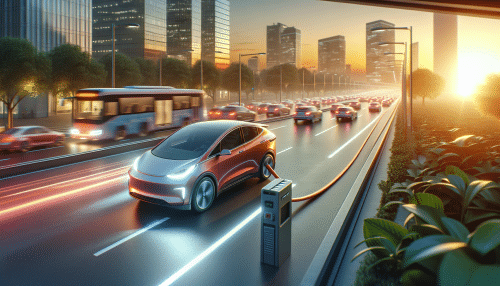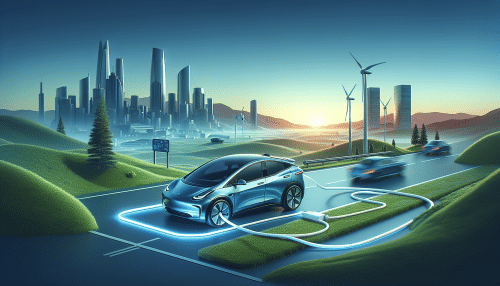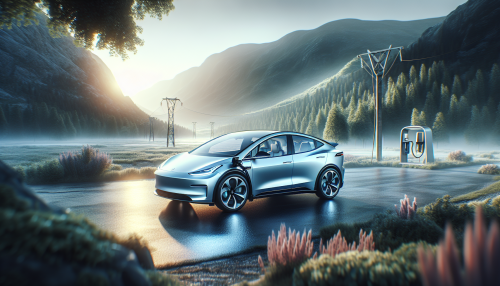You May Be Overlooking These Electric Car Insights
Brian Taylor November 19, 2025
Electric cars are reshaping how many people think about transportation and sustainability. This article explores key factors affecting electric car adoption, costs, charging options, incentives, and maintenance, offering insights for anyone curious about new automotive trends.
Understanding Electric Vehicles and Their Rising Demand
Electric vehicles (EVs) are at the forefront of the automotive industry’s shift toward cleaner energy. Increasing awareness of carbon emissions and fuel efficiency is prompting drivers to explore greener alternatives. While gasoline vehicles remain dominant, manufacturers are investing in a range of electric options— from compact cars to larger SUVs, each providing distinct driving experiences. The demand for electric transportation grows as consumers become more conscious of long-term costs, environmental impact, and innovative technology available in electric vehicles (Source: https://afdc.energy.gov/vehicles/electric_basics.html).
The market for electric vehicles is expanding not just in urban centers but also in suburban and rural regions. Various automakers now offer plug-in hybrids and fully battery-powered models, allowing individuals to align their vehicle choice with unique lifestyle needs. Government initiatives and eco-friendly policies play critical roles in encouraging a shift toward sustainable mobility. These supportive measures include rebates, investments in charging infrastructure, and updates to automotive regulations, leading to broadening interest across demographics.
Reporting by the International Energy Agency shows a significant jump in electric vehicle sales globally over recent years. This momentum results partly from falling battery costs, better driving ranges, and increased public knowledge of the technology’s benefits. Public and private sector collaborations ensure that future infrastructure continues to support accelerating EV adoption. As a result, the auto industry’s evolution toward low-emission vehicles could reshape everything from fuel economy standards to city planning strategies, impacting everyday travel for many people (Source: https://www.iea.org/reports/global-ev-outlook-2023).
The Real Costs Involved With Electric Cars
One of the most frequently discussed topics around electric vehicles is cost. The sticker price of many electric cars has historically exceeded that of gasoline-powered models. However, advancements in battery technology and increased competition are resulting in new EVs launching at a variety of price points. Factor in lower fuel costs and reduced maintenance requirements, and the lifetime cost of owning an electric vehicle becomes increasingly appealing for many. Some drivers may find that the overall value outweighs the initial investment, especially with additional incentives (Source: https://www.energy.gov/eere/electricvehicles/saving-money-fuel-electric-vehicles).
Charging an electric car at home typically costs less per mile driven compared to gasoline fueling. Although the installation of a dedicated charging station at home can require upfront investment, energy costs for EVs are often, over time, lower on a per-mile basis. Some regions offer special rates for off-peak charging, helping users manage long-term expenses. Ultimately, the savings become noticeable when factoring in incentives, rebates, and running expenses over multiple years of use.
Maintenance also plays a role in overall costs. Electric vehicles feature fewer moving parts than traditional engines, meaning fewer opportunities for wear and tear. This reduction tends to translate into fewer repair needs, with brake wear, oil changes, and engine issues less common in the EV ownership experience. However, battery health and replacement are topics of concern for some consumers, making it important to compare manufacturer warranties and the latest battery reliability findings.
Charging Infrastructure and Everyday Usability
Reliable access to EV charging solutions is quickly becoming a top consideration for drivers interested in electric vehicles. The expansion of public and private charging options eases concerns about range anxiety, allowing users to travel with greater peace of mind. From Level 1 chargers suited for overnight household use to fast-charging stations along major highways, charging infrastructure is now widely available in most metropolitan areas. Mapping tools and smartphone apps simplify locating convenient charging points near shopping centers, workplaces, and other frequent destinations (Source: https://afdc.energy.gov/fuels/electricity_infrastructure.html).
Some users choose to install home chargers to make the most of overnight electricity rates or renewable energy integration. Home charging can make daily vehicle use seamless, especially for those with predictable driving patterns. Conversely, micro-mobility options and charger-sharing networks are growing, enabling renters and people without garages to still benefit from electric vehicle ownership. Planning daily routines with charging needs in mind is key for a positive long-term EV experience.
Advancements in battery charging speed continue to evolve, reducing wait times at public stations. Some public chargers can now add hundreds of miles of range in as little as 30 minutes. This progress is crucial for long-distance travel or busy schedules, making EV ownership suitable for a wider audience. Innovations in wireless charging and solar-powered stations may further shape the convenience and accessibility of electric mobility over the coming years.
Government Incentives and Environmental Impact
Government support remains a powerful motivator in electric vehicle adoption. Many countries, states, and municipalities offer incentives, including tax credits, rebates, and discounts on registration or toll fees, to lower the effective cost of electric vehicle ownership. By rewarding early adopters and fleets, these incentives stimulate market growth and encourage a transition away from fossil fuels toward cleaner energy solutions (Source: https://afdc.energy.gov/laws/electric-vehicles).
EVs produce zero tailpipe emissions during operation, which supports efforts to improve air quality in urban environments. Depending on the energy mix used to generate electricity, the lifetime emissions of electric vehicles can be substantially lower than those of gasoline-powered counterparts. Policymakers continue to refine and expand green energy resources, aiming for electrified mobility that is truly sustainable from cradle to grave.
Beyond emissions, electric vehicles spur conversations about battery sourcing, recycling, and ethical material supply chains. Major manufacturers are pledging to improve battery recycling programs and reduce dependency on conflict minerals. Nonprofits, researchers, and government agencies actively monitor the supply chain to ensure the next era of transportation meets higher standards of environmental stewardship and social responsibility (Source: https://www.epa.gov/greenvehicles/electric-vehicle-myths).
Exploring Upkeep, Longevity, and Warranty Coverage
Upkeep of electric cars is frequently a point of interest for potential owners. With fewer mechanical parts, the risk of issues involving the drivetrain, ignition, or fluids is minimized compared to traditional vehicles. Most maintenance costs revolve around tire rotation, brake checks, and battery health monitoring. Many major automakers provide transparent maintenance schedules specifically tailored for electric models, making ownership less unpredictable and often more convenient.
Longevity and reliability have been steadily improving as technology matures. High-quality battery packs are designed for extended life, with some manufacturers offering warranties that last for several years or tens of thousands of miles. Proactive monitoring systems alert drivers to any potential performance or battery issues, and specialized service centers are increasingly available to address unique maintenance needs arising in electric vehicles.
It’s common for prospective buyers to carefully review warranty coverage, particularly for the battery and drivetrain. Some brands offer comprehensive warranties on critical components, helping to mitigate concerns about long-term risk or future replacement costs. Consumers benefit from researching the latest reviews, manufacturer commitments, and lessons learned from early adopters to make well-informed decisions about vehicle longevity and peace of mind (Source: https://www.consumerreports.org/cars/hybrid-ev/ev-battery-replacement-cost-what-to-know-a9015454367/).
Future Innovations in the Electric Car Industry
The electric vehicle industry is a hub for cutting-edge innovation. Advances in battery technology promise even longer driving ranges and faster recharging times, aiming to address the remaining barriers to mainstream adoption. Vehicle-to-grid technology, software updates, and autonomous driving systems are reshaping the future of transport, turning electric cars into more than just a mode of travel—these are now smart devices on wheels.
Collaborations between automotive manufacturers, technology companies, and public agencies set the stage for rapid progress. The result is a stream of new features that enhance safety, driver assistance, energy storage, and connectivity. Research and pilot programs, funded by both the private and public sectors, continue to yield discoveries that may alter not just how people drive, but how society thinks about mobility as a whole (Source: https://www.nrel.gov/transportation/electric-vehicle-infrastructure.html).
Expect developments in wireless charging, energy-dense battery chemistry, and even lightweight manufacturing materials designed to further efficiency gains. The emerging landscape points toward a world where electric transportation is the standard, supported by smarter infrastructure and a focus on sustainability. Keeping up with these innovations is key for anyone interested in the future of cars and technology.
References
1. U.S. Department of Energy. (n.d.). Electric Vehicle Basics. Retrieved from https://afdc.energy.gov/vehicles/electric_basics.html
2. International Energy Agency. (n.d.). Global EV Outlook. Retrieved from https://www.iea.org/reports/global-ev-outlook-2023
3. U.S. Department of Energy. (n.d.). Saving on Fuel and Vehicle Costs. Retrieved from https://www.energy.gov/eere/electricvehicles/saving-money-fuel-electric-vehicles
4. Alternative Fuels Data Center. (n.d.). Electric Vehicle Charging Infrastructure Trends. Retrieved from https://afdc.energy.gov/fuels/electricity_infrastructure.html
5. U.S. Department of Energy. (n.d.). Laws and Incentives for Electric Vehicles. Retrieved from https://afdc.energy.gov/laws/electric-vehicles
6. U.S. Environmental Protection Agency. (n.d.). Electric Vehicle Myths. Retrieved from https://www.epa.gov/greenvehicles/electric-vehicle-myths





